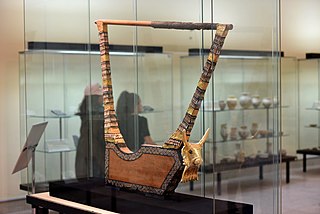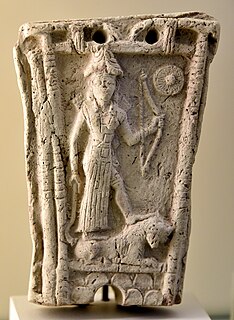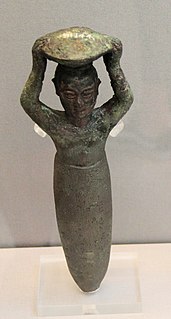Related Research Articles

Nanna, Sīn or Suen, and in Aramaic syn, syn’, or even shr 'moon', or Nannar was the god of the moon in the Mesopotamian religions of Sumer, Akkad, Assyria, Babylonia and Aram. He was also associated with cattle, perhaps due to the perceived similarity between bull horns and the crescent moon. He was always described as a major deity, though only a few sources, mostly these from the reign of Nabonidus, consider him to be the head of the Mesopotamian pantheon.

Ningal, also known as Nikkal in Akkadian, was a Mesopotamian goddess of Sumerian origin regarded as the wife of the moon god, Nanna/Sin. She was particularly closely associated with his main cult centers, Ur and Harran, but they were also worshiped together in other cities of Mesopotamia. She was particularly venerated by the Third Dynasty of Ur and later by kings of Larsa.
Ninšar was a Mesopotamian goddess commonly associated with the preparation of meat. The reading of her name remains uncertain, and its possible etymology appears to be unrelated to her role in the Mesopotamian pantheon. She was chiefly worshiped in Nippur, though her original cult center was the settlement AB.NAGAR.

Ninsun was a Mesopotamian goddess. She is best known as the mother of the hero Gilgamesh and wife of deified legendary king Lugalbanda, and appears in this role in most versions of the Epic of Gilgamesh. She was associated with Uruk, where she lives in this composition, but she was also worshiped in other cities of ancient Mesopotamia, such as Nippur and Ur, and her main cult center was the settlement KI.KALki.
Ninkasi was the Mesopotamian goddess of beer and brewing. It is possible that in the first millennium BCE she was known under the variant name Kurunnītu, derived from a term referring to a type of high quality beer. She was associated with both positive and negative consequences of the consumption of beer. In god lists, such as the An = Anum list and the Weidner list, she usually appears among the courtiers of the god Enlil, alongside deities such as Ninimma and Ninmada. She could also be paired with Siraš, a goddess of similar character, who sometimes was regarded as her sister. A possible association between her and the underworld deities Nungal and Laṣ is also attested, possibly in reference to the possible negative effects of alcohol consumption.

Damgalnuna, also known as Damkina, was a Mesopotamian goddess regarded as the wife of the god Enki. Her character is poorly defined in known sources, though it is known that like her husband she was associated with ritual purification and that she was believed to intercede with him on behalf of supplicants. Among the deities regarded as their children were Nanshe and Asalluhi. While the myth Enki and Ninhursag treats her as interchangeable with the goddess metioned in its title, they were usually separate from each other. The cities of Eridu and Malgium were regarded as Damgalnuna's cult center. She was also worshiped in other settlements, such as Nippur, Sippar and Kalhu, and possibly as early as in the third millennium BCE was incorporated into the Hurrian pantheon. She appears in a number of myths, including the Enūma Eliš, though only a single composition, Damkina's Bond, is focused on her.
Siris or Siraš was a Mesopotamian goddess associated with beer. She was also worshiped in Ebla, where her name was spelled as Zilaš. Cognates of her name are also present as terms referring to alcoholic beverages or deities associated with them in languages such as Ugaritic and Hebrew. She was closely associated with another goddess of similar character, Ninkasi, though the nature of the connection between them varies between sources. She is attested in a variety of texts, including god lists, offering lists and a variant of the Ballad of Early Rulers.
Ninti was a Mesopotamian goddess worshiped in Lagash. She was regarded as the mother of Ninkasi. She also appears in the myth Enki and Ninhursag as one of the deities meant to soothe the eponymous god's pain. In this text, her name is reinterpreted first as "lady rib" and then as "lady of the month" through scribal word play.
Ninegal or Belat Ekalli (Belet-ekalli) was a Mesopotamian goddess associated with palaces. Both her Sumerian and Akkadian name mean "lady of the palace."
Shuzianna was a Mesopotamian goddess. She was chiefly worshiped in Nippur, where she was regarded as a secondary spouse of Enlil. She is also known from the enumerations of children of Enmesharra, while in the myth Enki and Ninmah she is one of the seven minor goddesses helping with the creation of mankind.

Sukkal was a term which could denote both a type of official and a class of deities in ancient Mesopotamia. The historical sukkals were responsible for overseeing the execution of various commands of the kings and acted as diplomatic envoys and translators for foreign dignitaties. The deities referred to as sukkals fulfilled a similar role in mythology, acting as servants, advisors and envoys of the main gods of the Mesopotamian pantheon, such as Enlil or Inanna. The best known sukkal is the goddess Ninshubur. In art, they were depicted carrying staffs, most likely understood as their attribute. They could function as intercessory deities, believed to mediate between worshipers and the major gods.
Ningirima was a Mesopotamian goddess associated with incantations, attested already in the Early Dynastic period. She was also associated with snakes, fish and water. According to the god list An = Anum and other sources, she was regarded as a sister of Enlil. While suggestions that she was conflated with the mongoose deity Ninkilim can be found in modern literature, this theory finds no direct support in primary sources.
Ninmug or Ninmuga was a Mesopotamian goddess. She was associated with artisanship, especially with metalworking, as evidenced by her epithet tibira kalamma, "metalworker of the land." She could also be regarded as a goddess of birth and assistant of Ninmah, most likely because the fashioning of statues of deities and the birth of children could be described with the same terms in Sumerian texts. Her main cult centers were Kisiga, whose location remains uncertain, and Adab.

Ningizibara, also known as Igizibara and Ningizippara, was a Mesopotamian goddess associated with the balaĝ instrument, usually assumed to be a type of lyre. She could be regarded both as a physical instrument and as a minor deity. In both cases, she was associated with the goddess Inanna. A connection between her and the medicine goddess Gula is also attested, and it is possible she could serve as a minor healing deity herself.
Šassūrātu were a group of Mesopotamian goddesses regarded as the assistants of Ninmah. Their name can be translated as "midwives" and they were considered to be tutelary goddesses of pregnant women. They appear in the myth Enki and Ninmah, where they receive individual names, as well as in a late version of Atrahasis.
Ninirigal or Ninirigala was a Mesopotamian goddess associated with Kullaba, a district belonging to the city of Uruk. Her character is poorly known beyond her role as a tutelary goddess of this area. Her husband was a god known under the name Nunbaranna, most likely an epithet of the fire god Gibil.
Ninsikila was a Mesopotamian deity regarded as the spouse of Lisin. Early sources refer to him as male, but later on the name came to refer to a goddess instead. The change in gender might have been influenced by an association with the Dilmunite goddess Meskilak, also called Ninsikila in Mesopotamia, or by Lisin's placement before her spouse in god lists. Texts attesting the worship of Ninsikila include an inscription from Larsa and a magical formula from Meturan.

Epithets of Inanna were titles and bynames used to refer to this Mesopotamian goddess and to her Akkadian counterpart Ishtar. In Mesopotamia, epithets were commonly used in place of the main name of the deity, and combinations of a name with an epithet similar to these common in ancient Greek religion are comparatively uncommon. Inanna had more titles than any other Mesopotamian deity. They pertained to her associations with specific cities or areas, such as Uruk, Zabalam, Akkad, Nineveh or the Sealand. Other instead highlighted her specific roles, for example these of an astral goddess personifying the planet Venus or of a war deity. In some cases, her individual epithets eventually developed into separate deities.

Inanna of Zabalam was a hypostasis of the Mesopotamian goddess Inanna associated with the city of Zabalam. It has been proposed that she was initially a separate deity, perhaps known under the name Nin-UM, who came to be absorbed by the goddess of Uruk at some point in the prehistory of Mesopotamia and lost her unknown original character in the process, though in certain contexts she nonetheless could still be treated as distinct. She was regarded as the mother of Shara, the god of Umma, a city located near Zabalam.
Ninura was a Mesopotamian goddess associated with the state of Umma. The god Shara, worshiped in the same area, was regarded as her husband. She is only attested in sources from the third millennium BCE. Her cult started to decline in the Ur III period, and she is no longer attested in Old Babylonian texts. Other goddesses replaced her in both of her roles, with Inanna of Zabalam becoming the goddess of Umma, and Usaḫara or Kumulmul taking her place as Shara's spouse.
References
- 1 2 Jacobsen 1978, p. 124.
- 1 2 3 Cavigneaux & Krebernik 1998, p. 361.
- ↑ Litke 1998, p. 88.
- ↑ Jacobsen 1992, p. 4.
- 1 2 Jacobsen 1978, pp. 124–125.
- ↑ Litke 1998, p. 120.
- ↑ Asher-Greve & Westenholz 2013, p. 109.
Bibliography
- Asher-Greve, Julia M.; Westenholz, Joan G. (2013). Goddesses in Context: On Divine Powers, Roles, Relationships and Gender in Mesopotamian Textual and Visual Sources (PDF). ISBN 978-3-7278-1738-0.
- Cavigneaux, Antoine; Krebernik, Manfred (1998), "Nin-gikuga", Reallexikon der Assyriologie (in German), retrieved 2022-11-20
- Jacobsen, Thorkild (1978). The Treasures of Darkness. Yale University Press. doi:10.12987/9780300161823. ISBN 978-0-300-16182-3.
- Jacobsen, Thorkild (1992). "The New House". The Harps that Once... Sumerian Poetry in Translation. Yale University Press. doi:10.12987/9780300161878-003.
- Litke, Richard L. (1998). A reconstruction of the Assyro-Babylonian god lists, AN:dA-nu-um and AN:Anu šá Ameli (PDF). New Haven: Yale Babylonian Collection. ISBN 978-0-9667495-0-2. OCLC 470337605.